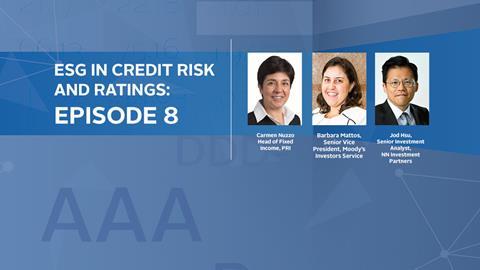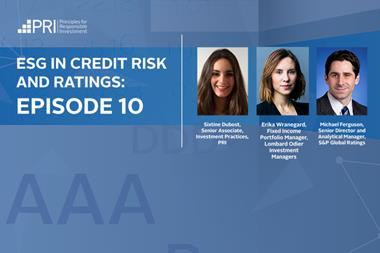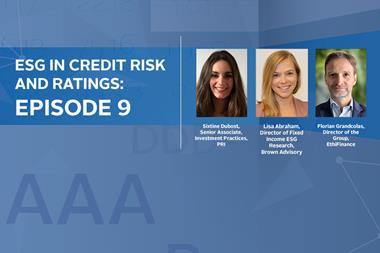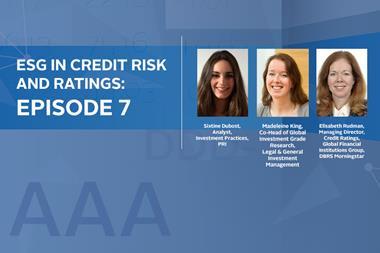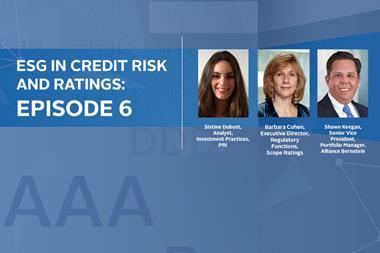ESG IN CREDIT RISK AND RATINGS: EPISODE 8 – DEFORESTATION
With Carmen Nuzzo, Head of Fixed income, PRI, Barbara Mattos, Senior vice president, Moody’s Investors Service and Jod Hsu, Senior investment analyst, NN Investment Partners
Note: The Principles for Responsible Investment podcast is designed to be heard. If you are unable to do this, this transcript offers an insight into the episode.
Transcripts are generated using a combination of speech recognition software and human transcribers, and may contain the occasional error. Please check the corresponding audio before quoting in print.
Subscribe to the channel via Apple podcasts, Spotify, or wherever you listen to your podcasts.
Carmen Nuzzo
Welcome to the PRI podcast and the latest episode in our ESG in credit risk and rating series. My name is Carmen Nuzzo. I’m the head of fixed income at the PRI. And I’m delighted to be your host today.
More than half of the world’s GDP is moderately to highly dependent on nature and its services. According to the world economic forum, the unprecedented loss of biodiversity creates risks for the society and businesses that can result in significant negative economic and social outcomes. It also affects credit risks, that is the probability of the four to corporate or sovereign debt issuers yet fixed income investors are still in the early stages of incorporating the systemic risk in their analysis when they make investment decisions beyond some sectors, such as food or timber productions, where they’ve been clearly material for a while.
Today, I’m joined by Barbara Mattos, senior vice president at Moodi’s investor service and Jod Hsu, senior investment analyst at NN investment partners.
Barbara, we often look at biodiversity and especially deforestation through its impact on climate change and social considerations. Do you think that biodiversity loss can affect insurers credit risk as well?
Barbara Mattos
Yes. Deforestation and biodiversity laws can definitely affect credit quality. The impact may not always be immediately material to credit quality, but there are a number of ways through which it can be quickly become more significant. In particular, if societal and regulatory scrutiny intensify, and we start to see boycotts, bans affecting revenues and reputational risks increasing. Deforestation also raises risk of higher operational costs and higher investments towards the need to adapt business models or comply with regulations and also for initiatives to ensure supply chain monitoring, which is particularly the situation faced by protein companies in Brazil, for example, and that the overall higher risk may translate into higher funding costs or potential even for fines for no compliance. I just mentioned the protein industry, which together with the agriculture sector have the greatest exposure to, to environmental and, and social risks from the forestation.
But other sectors are certain extent. It also linked to deforestation given their reliance and use of natural resources, but maybe not at the level of protein and agriculture activities in particular when we consider the Amazon and then the cerrado regions in Brazil. For example, Brazil’s top producers maybe many people may, might guess that this sector is a big contributor to deforestation, but we see that large players in Brazil have a strong track record of obtain fiber from certified sources, which limits their exposure to deforestation through their operations or supply chain. So protein and agriculture companies are, are those whose deforestation efforts matter the most. Major companies in, in Brazil have communicated their pro in, in specific initiatives to eliminate deforestation, their supply chains. However, they cannot yet ensure zero deforestation from indirect suppliers. In that we also see risks for companies perceived to be link it to deforestation that can have implications to credit quality over time.
Carmen Nuzzo
So it’s great day that you’ve highlighted that for some sector that these risks are much more apparent for others, not so, but I’m also grateful that you highlighted various channels through which credit risk might emerge for, for initial, and definitely the experience that we’ve had with workshops that we’ve conducted last year with food companies shows that some of them are actually quite advanced in terms of putting already policies in place to ensure that deforestation is full. From a credit rating agency perspective.
Barbara Mattos
Well it’s part of our ESG analysis with increasing concern, zone, physical climate risk, carbon transition, and the challenges of Brazil and Brazilian companies coming from the forestation. We thought it would be an interesting topic to look into and try to identify potential credit implications to issues. But overall our approach to ESG has not changed, but it has, it has evolved as we, you know, we seek to incorporate all material credit considerations, including ESG risks into our ratings and to take the most forward looking perspective that we can. Right, what has maybe is that we have made more progress to become more transparent and, and systematic in our assessment of ESG considerations. And that includes the publication of our ESG classification, the heat maps for environmental and, and social risks. And more recently we have introduced issuer specifically ESG score. So with that, we have the framework to look into specific risks, which is the case of deforestation.
Carmen Nuzzo
Yeah. And as you said, the analysis has evolved and we’ve been very pleased to have Moody’s supporting the PRI ESG and credit risk and ratings initiative, which aim precisely at that and making ESG factors more transparent and systematic in the analysis. Jod, as an investor, do you agree with some of the considerations that Barbara has made?
Jod Hsu
Yeah, I think I agree. I mean, investors, if we’re talking about the first, it’s a longer term theme, right. I mean, the impact will not be materialised in the short term, but in long run, it will have impact. And also, so does the biodiversity, and I think like it’s increasingly important for us as investor to look at and address this kind of issues, because like, yeah, in the end, like it’s, it’s a long run again. We want to contribute to more like sustainable society and so making progress there. And so we are, I think investors are increasing or more frequently at the look at the issue. And for example, like sometimes there’s investors and have a questionnaire for companies that are highly exposed to deforestation risk for some of the agriculture products, such like as cattle, soy, palm oils.
And we also looking at the company policies and conducting engagement programs. I think in NNIP differs station is on the quite high priorities in terms of engagement efforts. But from a credit investor perspective is quite difficult. Is that how to incorporate the risk? Because, I mean, if we are bond investors, if you invest in a three-year bond, the risk might not be that material compared to a, if you invest in like a 15 year bond. So how to incorporate that kind of risk with a different timeframe is quite difficult for fiscal income investors.
Carmen Nuzzo
Yeah. The issue of time horizons is actually something that we’ve been discussing quite a lot throughout the time that we’ve been working with investors and credit rating agencies on various ESG topics. It’s seen as a complication or a barrier, but I also like to think that it offers more flexibility in a way, in terms of the of investment options, but it’s an important one that should not be forgotten. And as you rightly Jod, most of the time, the first can be seen as a long term factor, not necessarily impact short term investment.
Barbara, let me come back to you. Can deforestation affect credit risk also via social implications, not only because of the environmental factors or the environmental consequences.
Barbara Mattos
Yes, Carmen, definitely. I guess the social aspect is also very relevant you know, damages to, to natural system can systems can also have a significant impact on, on communities that rely on, on the resources. Right? So, and, and what we are seeing today is that societal scrutiny has moved beyond the impact on natural capital from direct business or direct operations to include indirect impact through supply chains. We see increased transparency required to either labelling product, certification to comply with, or, or enforce more, more global standards. When we look at protein and agriculture companies the, the question is really about traceability of commodities, right? Mostly soybean and beef when we think about Brazil, but along the entire value chain. And also it’s very important the monitoring of suppliers involvement in deforestation
Carmen Nuzzo
And talking about supply chain, I want to go back to something that Jod mentioned earlier regarding engagement. Jod, how important is the role of investor corporate engagement and tackling biodiversity laws in a specifically deforestation?
Jod Hsu
I think we can really definitely play a very important role there because like when talking about engagement a lot of people will think about equity investors from equity investors, particularly because this deforestation is very long run thing, but however, a lot of those companies, which has quite high deforestation risk also rely heavily on depth financing. So I think in, from the fixed income investor perspective, we definitely have a saying there and also combine the strengths from the all pressure from the equity and the fixed income investor. Obviously, we can put much more pressure on the companies and also among, because like, we do have a lot of different in initiatives among all the asset managers. So we are tied together. We put pressure on the companies. We try to have a constructive dialogue with them.
I think this is a very important message there, because I mean, in the end, whether you have equity investor or fixed income investor, we want to achieve the same thing, right? Like in the wrong run, we have want to have a better world. We want to have a better society. So I think that’s there. And I think I, I have one quite interest single example here is for a fixed income investors because like NNIP is actually a steering company of an IPDD Indonesia initiative. So that’s an initiative investor combined with investor more than five 50 investors investing in Indonesia. So bonds. So we have initiative directly engagement with engaged with Indonesian government and that’s from the sovereign bond investors. So, which means that it’s a fixed income investor. So not only from corporate side, but from the government side as an investor, we can also engage.
Carmen Nuzzo
Thanks. And for those interested, the IPDD that Jod mentioned is the investor’s policy dialogue on deforestation that is working in particular on the initiative on Indonesia. Sticking to this angle about influencing and maybe shaping positive outcomes. How can investors actually positively influence the demand of food and raw materials from developed markets to developing countries to reduce deforestation? Maybe Barbara, do you want to go first?
Barbara Mattos
Yeah, sure. I see this influence coming from different channels, including changes in consumer habits, in investment decisions and also changes in regulations to reflect this, this society trends thinking about higher scrutiny from, from investors like Jod mentioned I guess. This brings the companies that need to be more compliant with requirements regarding deforestation standards in order to be able to, to continue to access financial markets remember that large players in the protein and agriculture industry for example, are also large players in, in that capital markets. If we look at large beef producers in Brazil, these companies have at least 50% of their total debt represented by cross border bones and over 60%, if we include that instruments in local currency. So they rely heavily on, on that capital markets for their, their funding needs.
But scrutiny also comes from customers. We have seen situations of European consumers supporting new laws to ensure that products that they buy do not drive global deforestation and so such interest or such public demand increases reputational risks and could potentially lead to even to boycotts. But at the same time, I guess companies are now more aware of all these issues and how they can impact their business and are more closely scrutinising there are operations and there’s supply chains regarding deforestation in the biodiversity loss.
Jod Hsu
I think it’s very important, right? And all those companies actually, they often supply multinational companies. And for example, food producers or retailers, which are under the scrutiny of investors, for example, like with NNIP we have like talks, for example, with Unilever about Palm oil, with Stand, on about soy. Then let’s say, if you want to be in the supply chain of these multinationals, there will be a high standard about your deforestation, practice and policies. So, I mean, because when we had the workshop last year, we also hear companies saying like, okay, we need to pay more attention to this. All this certificate, make more efforts to in the supply chain. So there’s a lot of pressure on the supplier side. So that’s, I think that’s very important. And I do think that it’s not only about the financing, it’s not only about like getting money from the investors, it’s about being able to remain again, be able to remain in the whole supply chain because the whole supply chain is pressured by both investors and consumers.
Carmen Nuzzo
And the workshop that Jod just mentioned is part of a series that the PRI has organised and is continuing to organise, bringing together fixed income investors, credit rating agencies, and corporates borrowers from different sectors. And the last year we convened a number of companies in the food sector, ranging from the producers all the way to the wholesalers and distributors. You both mentioned Barbara and Jod earlier, cost of funding, the role of capital markets. What do you think is the role of new types of financing solutions and in and instruments such as green forestry bonds, for example, encountering biodiversity loss and enabling net zero by 2050.
Barbara Mattos
I think it’s an important initiative, but maybe the market’s not yet mature. I think this type of financing is also relatively new to companies and they need to, to work on which KPIs will be selected, how they’ll be measured and how they can actually achieve these targets over time. For example, I mean, if we look at protein companies JBS should sustainability link bones targeting of reduction of green greenhouse gas emissions intensity over time. Marfrig another example we should a sustainability transition, bonds targeting acquisition of cattle producing the Amazon only from suppliers that respect their company’s environmental criteria. All other, other examples with also maybe different KPIs, Suzano in the forest sector issued a bond one that also targets reduction of intensity of greenhouse gas emissions, but another one that targets reduction of industrial water withdrawal, which I find in interesting because it also has an important social component, right?
Because water is needed on not only of course on the industrial process, but also for the, the population in, in surrounding areas. But in any case, I think the challenge here is that targets are not only dependent on the company itself, but also on the supply chain. So they can be perhaps be more difficult to achieve. So I, I think it’ll be interesting to see how successful companies meet targets overtime for now. I think I see these instruments at least helping companies showcase their, their commitments to, to reduce the negative impact on, of business on natural resources.
Carmen Nuzzo
Jod, and from the investor side. Do you agree with what Barbara just said?
Jod Hsu
I think, yeah, I agree. I mean, they’re in a good, in a way. I think it’s better than nothing, but I agree with Barbara, like the market is probably not mature yet, and those investors need to be very careful about the KPI, the company is choosing. So, but on the other hand, especially like whether the KPIs are ambitious enough, that’s very difficult. You could also argue that based on our discussions, those companies should do the things that they need to do. It’s kind of like a business as usual, right? And by issuing those bonds, how can you prove that you are making extra effort on the topic on the frustration? So, I think that’s quite difficult. And, and also, I think when Barbara talking about those KPIs, I mean, for green gas emissions, it’s relatively easy to judge whether the KPIs are ambitious enough or not. However, for the deforestation, I think it’s quite difficult for us as an investor to identify or determine what ambitious target guess or KPIs are, because it’s quite difficult for us to judge. So it’s, yeah, I think we are at the early stage, but I think the, the trend is constructive and investors just need to be careful and pay like highly scrutinise the KPIs.
Carmen Nuzzo
Yeah. And we always like to say at the PRI, when we talk to our signatories that yes, these instruments are useful to focus both issuers and investors on certain topics, but they shouldn’t be taken at face value. So a lot of due diligence should be done prior to buying them. And as you say, Jod investors should be careful and scrutinise them individually.
This brings us to the end of our conversation. Thank you so much, Barbara and Jod for sharing your experience and for a very insightful conversation. A reminder that this podcast series is part of a project called the ESG and credit risk and rating initiative, which Moody’s investor service and NN are supporting. You can find all the resources that we’ve produced so far on www.unpri.org/credit-ratings, where there is also a statement of support that can still be signed by PRI investor signatories. Thanks for listening. And don’t forget to tune in for our next podcast until then goodbye.
Downloads
The Principles for Responsible Investment podcast transcript
PDF, Size 0.21 mb


